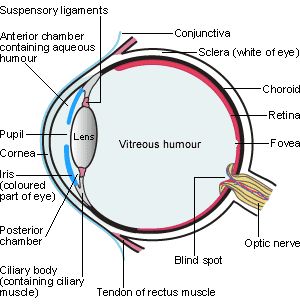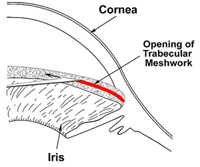Tonometry is a Medical technology used to measure the Ocular pressure. Tonometer is the instrument used in Ophthalmology for measuring the tension or intraocular pressure. Intraocular pressure is the pressure exerted by the fluid present in the eye. The pressure is determined in terms of milli meters of mercury (mmHg)

Ocular pressure
Ocular pressure is the normal pressure exerted by the fluid present in the eye. In front of the lens, the Aqueous chamber contains a crystal clear watery fluid called Aqueous humor. Behind the lens, the Vitreous chamber contains a jelly like vitreous humor. The normal intraocular pressure exerted by the fluid mainly the aqueous humor is between 10 mmHg and 20 mmHg. Average value is 15.5 mmHg with a fluctuation of 2.75 mmHg. Intraocular pressure varies throughout the night and day. The diurnal variation for normal eyes is between 3 and 6 mmHg. During the night, intraocular pressure usually decreases due to the slower production of aqueous humour. Intraocular pressure also varies with a number of other factors such as heart rate, respiration, exercise, fluid intake, systemic medication and topical drugs. Alcohol consumption leads to decrease in intraocular pressure and caffeine may increase intraocular pressure.

Internal Anatomy of Eye
The mathematical relationship between the secretion and outflow of the aqueous homuor is expressed as
Intraocular pressure (IOP) = F / C + PV
where F is the rate of formation of aqueous humour, C is the rate of absorption of aqueous humour and PV is the Episcleral venous pressure. Generally the IOP lies between 10 and 21 mmHg with a decrease or increase of 3.3mmHg in 24 hour cycle.

Path of absorption of Aqueous humour
Hyper pressure in the eye is referred to as Ocular Hypertension (OHT). This is caused by the reduction in the rate of absorption of aqueous humour, anatomical problems of eye, inflammation, drug effect etc. Elevation of IOP needs immediate medical attention. The method used to measure intraocular pressure is known as Tonometry.
Types of Tonometry
1. Applanation Tonometry
This is the method that infers the intraocular pressure from the force required to flatten a constant area of the cornea. A special disinfected prism mounted on the Tonometer head is placed against the cornea. A cobalt blue filter is used to view two green semi circles. The force applied to the Tonometer head is then adjusted using the dial until the inner edges of these green semicircles meet. Topical anesthetic drugs like oxybuprocaine, tetracaine, proparacaine are used on the surface of the eye before conducting Tonometry.
2. Goldmann Tonometry
Goldmann Tonometry is the most widely accepted method of determining intraocular pressure. It is done by flattening an area of 3.06mm and the intraocular pressure can be determined from the force applied.
3. Pascal Tonometry
The PASCAL Tonometer is currently the only commercial DCT Tonometer available. It uses a miniature pressure sensor embedded within a Tonometer tip contour-matched to the shape of the cornea. The Tonometer tip rests on the cornea with a constant appositional force of one gram. When the sensor is subjected to a change in pressure, the electrical resistance is altered and the PASCAL’s computer calculates a change in pressure in concordance with the change in resistance.
4. Tono pen
The Tono-Pen is a portable Tonometer. Topical anesthetic eye drops are used to numb the numb the eye and the device is placed against the cornea. An outer ring flattens the cornea adjacent to the area of measurement allowing a free floating transducer to detect the transmitted pressure.

Tonometer
Use of Tonometry
Tonometry is done as part of a regular eye examination to check for increased intraocular pressure (IOP), which increases your risk of glaucoma. Tonometry can be used to see if medicine is keeping your IOP below a certain target pressure set by your doctor
Filed Under: Electronic Projects


Questions related to this article?
👉Ask and discuss on EDAboard.com and Electro-Tech-Online.com forums.
Tell Us What You Think!!
You must be logged in to post a comment.